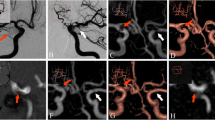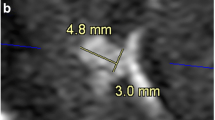Abstract
Purpose
To determine the diagnostic accuracy of 3D time of flight MR angiography (TOF-MRA), contrast enhanced MR angiography (CE-MRA), and T1-weighted high-resolution isotropic volume examination (THRIVE) at 3 T for the evaluation of intracranial aneurysm occlusion after endovascular treatment and to evaluate the usability of the THRIVE sequence in endovascular treatment follow-up.
Methods
In 3 T MR follow-up examinations of 66 aneurysms in 50 patients treated endovascularly, 3D TOF-MRA (index test), THRIVE (index test), and CE-MRA (reference standard) examinations were performed in a retrospective consecutive case series. Source images were classified as class 1, class 2, and class 3 according to the Raymond criteria using MIP (maximum intensity projection) techniques. The compatibility between sequences was evaluated with the Kappa test. The sensitivity and specificity were also calculated.
Results
In the evaluation of THRIVE and CE-MRA sequences, compatibility was determined in 61 cases in total, with an overall fit of 61/66 (92.42%). A statistically significant correlation was found between THRIVE and CE-MRA (p < 0.001, κ = 0.800). In the evaluation of TOF and CE-MRA sequences, compatibility was determined in 54 cases in total, and the overall fit was 54/66 (81.8%). A statistically significant agreement was found between TOF and CE-MRA (p < 0.001, κ = 0.502). Assuming that CE-MRA is a reference standard, the sensitivity and specificity of the TOF sequence were 44.4% and 97.9%, respectively, and the sensitivity and specificity of the THRIVE sequence were 77.8% and 97.9%, respectively.
Conclusion
The THRIVE sequence can be used as a noncontrast method for monitoring endovascularly treated intracranial aneurysms.






Similar content being viewed by others
Availability of data and material
The data that support the findings of this study are available from the corresponding author upon reasonable request.
References
Molyneux A, Kerr R, Stratton I, Sandercock P, Clarke M, Shrimpton J, Holman R, International Subarachnoid Aneurysm Trial Collaborative G (2002) International Subarachnoid Aneurysm Trial (ISAT) of neurosurgical clipping versus endovascular coiling in 2143 patients with ruptured intracranial aneurysms: a randomised trial. Lancet 360(9342):1267–1274. https://doi.org/10.1016/s0140-6736(02)11314-6
Cognard C, Weill A, Castaings L, Rey A, Moret J (1998) Intracranial berry aneurysms: angiographic and clinical results after endovascular treatment. Radiology 206(2):499–510. https://doi.org/10.1148/radiology.206.2.9457205
Cognard C, Weill A, Spelle L, Piotin M, Castaings L, Rey A, Moret J (1999) Long-term angiographic follow-up of 169 intracranial berry aneurysms occluded with detachable coils. Radiology 212(2):348–356. https://doi.org/10.1148/radiology.212.2.r99jl47348
Wilms G, Bosmans H, Demaerel P, Marchal G (2001) Magnetic resonance angiography of the intracranial vessels. Eur J Radiol 38:10–18. https://doi.org/10.1016/S0720-048X(01)00285-6
Berteloot D, Leclerc X, Leys D, Krivosic R, Pruvo JP (1999) Cerebral angiography: a study of complications in 450 consecutive procedures. J Radiol 80(8):843–848
Kapsalaki EZ, Rountas CD, Fountas KN (2012) The role of 3 Tesla MRA in the detection of intracranial aneurysms. Int J Vasc Med 2012:792834–792839. https://doi.org/10.1155/2012/792834
Agid R, Schaaf M, Farb R (2012) CE-MRA for follow-up of aneurysms post stent-assisted coiling. Interv Neuroradiol 18(3):275–283. https://doi.org/10.1177/159101991201800305
Tartari S, Rizzati R, Righi R, Deledda A, Capello K, Soverini R, Benea G (2011) High-resolution MRI of carotid plaque with a neurovascular coil and contrast-enhanced MR angiography: one-stop shopping for the comprehensive assessment of carotid atherosclerosis. AJR Am J Roentgenol 196(5):1164–1171. https://doi.org/10.2214/AJR.10.4751
Trossbach M, Hartmann M, Braun C, Sartor K, Hahnel S (2004) Small vessel stents for intracranial angioplasty: in vitro evaluation of in-stent stenoses using CT angiography. Neuroradiology 46(6):459–463. https://doi.org/10.1007/s00234-004-1205-3
Gonner F, Heid O, Remonda L, Nicoli G, Baumgartner RW, Godoy N, Schroth G (1998) MR angiography with ultrashort echo time in cerebral aneurysms treated with Guglielmi detachable coils. AJNR Am J Neuroradiol 19(7):1324–1328
Lovblad KO, Yilmaz H, Chouiter A, San Millan Ruiz D, Abdo G, Bijlenga P, de Tribolet N, Ruefenacht DA (2006) Intracranial aneurysm stenting: follow-up with MR angiography. J Magn Reson Imaging 24(2):418–422. https://doi.org/10.1002/jmri.20642
Leclerc X, Navez JF, Gauvrit JY, Lejeune JP, Pruvo JP (2002) Aneurysms of the anterior communicating artery treated with Guglielmi detachable coils: follow-up with contrast-enhanced MR angiography. AJNR Am J Neuroradiol 23(7):1121–1127
Tsuruda J, Saloner D, Norman D (1992) Artifacts associated with MR neuroangiography. AJNR Am J Neuroradiol 13(5):1411–1422
Gauvrit JY, Leclerc X, Pernodet M, Lubicz B, Lejeune JP, Leys D, Pruvo JP (2005) Intracranial aneurysms treated with Guglielmi detachable coils: usefulness of 6-month imaging follow-up with contrast-enhanced MR angiography. AJNR Am J Neuroradiol 26(3):515–521
Agid R, Willinsky RA, Lee SK, Terbrugge KG, Farb RI (2008) Characterization of aneurysm remnants after endovascular treatment: contrast-enhanced MR angiography versus catheter digital subtraction angiography. AJNR Am J Neuroradiol 29(8):1570–1574. https://doi.org/10.3174/ajnr.A1124
Shankar JJ, Lum C, Parikh N, dos Santos M (2010) Long-term prospective follow-up of intracranial aneurysms treated with endovascular coiling using contrast-enhanced MR angiography. AJNR Am J Neuroradiol 31(7):1211–1215. https://doi.org/10.3174/ajnr.A2064
Buhk JH, Kallenberg K, Mohr A, Dechent P, Knauth M (2008) No advantage of time-of-flight magnetic resonance angiography at 3 Tesla compared to 1.5 Tesla in the follow-up after endovascular treatment of cerebral aneurysms. Neuroradiology 50(10):855–861. https://doi.org/10.1007/s00234-008-0413-7
Kaufmann TJ, Huston J 3rd, Cloft HJ, Mandrekar J, Gray L, Bernstein MA, Atkinson JL, Kallmes DF (2010) A prospective trial of 3 T and 1.5 T time-of-flight and contrast-enhanced MR angiography in the follow-up of coiled intracranial aneurysms. AJNR Am J Neuroradiol 31(5):912–918. https://doi.org/10.3174/ajnr.A1932
Urbach H, Dorenbeck U, von Falkenhausen M, Wilhelm K, Willinek W, Schaller C, Flacke S (2008) Three-dimensional time-of-flight MR angiography at 3 T compared to digital subtraction angiography in the follow-up of ruptured and coiled intracranial aneurysms: a prospective study. Neuroradiology 50(5):383–389. https://doi.org/10.1007/s00234-007-0355-5
Majoie CB, Sprengers ME, van Rooij WJ, Lavini C, Sluzewski M, van Rijn JC, den Heeten GJ (2005) MR angiography at 3 T versus digital subtraction angiography in the follow-up of intracranial aneurysms treated with detachable coils. AJNR Am J Neuroradiol 26(6):1349–1356
Brunereau L, Cottier JP, Sonier CB, Medioni B, Bertrand P, Rouleau P, Sirinelli D, Herbreteau D (1999) Prospective evaluation of time-of-flight MR angiography in the follow-up of intracranial saccular aneurysms treated with Guglielmi detachable coils. J Comput Assist Tomogr 23(2):216–223. https://doi.org/10.1097/00004728-199903000-00009
Boulin A, Pierot L (2001) Follow-up of intracranial aneurysms treated with detachable coils: comparison of gadolinium-enhanced 3D time-of-flight MR angiography and digital subtraction angiography. Radiology 219(1):108–113. https://doi.org/10.1148/radiology.219.1.r01mr06108
Kwee TC, Kwee RM (2007) MR angiography in the follow-up of intracranial aneurysms treated with Guglielmi detachable coils: systematic review and meta-analysis. Neuroradiology 49(9):703–713. https://doi.org/10.1007/s00234-007-0266-5
Panyaping T, Wongpanich G, Sangfai O, Tritanon O (2018) Comparison of contrast-enhanced 3D spoiled gradient-echo high-resolution T1-weighted sequences versus contrast-enhanced MR venography for detection of dural venous sinus thrombosis. Rama Med J 41:44–53
Metens T, Rio F, Baleriaux D, Roger T, David P, Rodesch G (2000) Intracranial aneurysms: detection with gadolinium-enhanced dynamic three-dimensional MR angiography-initial results. Radiology 216(1):39–46. https://doi.org/10.1148/radiology.216.1.r00jl1139
Roy D, Milot G, Raymond J (2001) Endovascular treatment of unruptured aneurysms. Stroke 32(9):1998–2004. https://doi.org/10.1161/hs0901.095600
Funding
No funding was received for this research.
Author information
Authors and Affiliations
Corresponding author
Ethics declarations
Conflict of interest
All authors declare that they have no conflict of interest.
Ethical approval
All procedures performed in studies involving human participants were in accordance with the ethical standards of Bursa Uludag University and with the 1964 Helsinki declaration and its later amendments or comparable ethical standards.
Informed consent
Requirement for informed consent was waived by IRB of Bursa Uludag University.
Additional information
Publisher’s note
Springer Nature remains neutral with regard to jurisdictional claims in published maps and institutional affiliations.
Rights and permissions
About this article
Cite this article
Mırçık, E., Hakyemez, B. New technique: the use of the THRIVE sequence in the follow-up of patients who received endovascular intracranial aneurysm treatment. Neuroradiology 63, 399–407 (2021). https://doi.org/10.1007/s00234-020-02527-4
Received:
Accepted:
Published:
Issue Date:
DOI: https://doi.org/10.1007/s00234-020-02527-4




